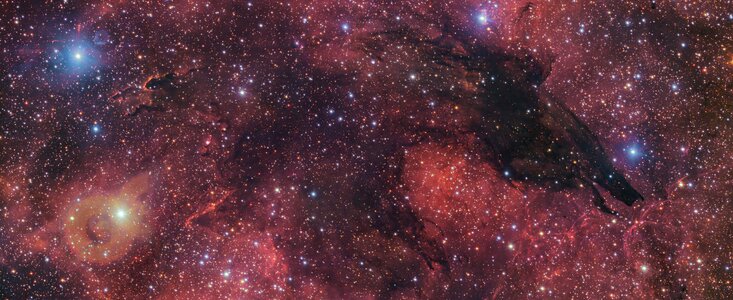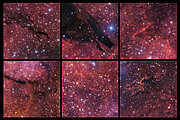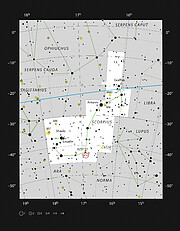Komunikat prasowy
Nowe zdjęcie z ESO pokazuje ciemnego wilka na niebie
31 października 2024
Europejskie Obserwatorium Południowe (ESO) prezentuje na Halloween upiorny obraz ciemnej mgławicy, która tworzy iluzję sylwetki przypominającej wilka na kolorowym kosmicznym tle. Odpowiednio nazwana Mgławicą Ciemnego Wilka, została uchwycona na obrazie o 283 milionach pikseli przez VLT Survey Telescope (VST) w należącym do ESO Obserwatorium Paranal w Chile.
Mgławica Ciemnego Wilka widoczna na niebie w gwiazdozbiorze Skorpiona, blisko centrum Drogi Mlecznej, znajduje się około 5300 lat świetlnych od Ziemi. Niniejsze zdjęcie obejmuje obszar na niebie odpowiadający czterem tarczom Księżyca w pełni, ale faktycznie jest częścią jeszcze większej mgławicy o nazwie Gum 55. Gdy przyjrzymy się bliżej, wilk może być nawet wilkołakiem, z rękoma gotowymi do uchwycenia niczego nie podejrzewających przechodniów…
Jeśli ktoś sądził, że ciemność równa się pustce, powinien to przemyśleć jeszcze raz. Ciemne mgławice są zimnymi obłokami kosmicznego pyłu, tak gęstymi, że przesłaniają światło gwiazd i innych obiektów położonych za nimi. Jak sugeruje ich nazwa, nie emitują światła widzialnego, w przeciwieństwie do innych mgławic. Ziarna pyłu w ich wnętrzach absorbują światło widzialne i pozwalają przenikać jedynie promieniowaniu na dłuższych falach, takich jak podczerwień. Astronomowie badają takie obłoki zamarzniętego pyłu, ponieważ często zawierają one nowe gwiazdy w procesie powstawania.
Oczywiście śledzenie ducha wilka na niebie jest możliwe tylko dzięki kontrastowi z jasnym tłem. Zdjęcie pokazuje w spektakularnych szczegółach, jak ciemny wilk wyróżnia się na tle świecących obłoków gwiazdotwórczych za nim. Kolorowe obłoki składają się głównie z gazu wodorowego i świecą w czerwonawym odcieniu wzbudzane intensywnym promieniowaniem ultrafioletowym od nowonarodzonych gwiazd.
Niektóre ciemne mgławice, takie jak Mgławica Worek Węgla, można zobaczyć gołym okiem – i odgrywają nawet kluczową rolę w tym, jak pierwsze narody interpretowały niebo [1] – nie dotyczy to jednak Ciemnego Wilka. Niniejsze zdjęcie utworzono dzięki danym z VLT Survey Telescope, należacego do Narodowego Instytutu Astrofizycznego we Włoszech (INAF) i znajdującego się w należącym do ESO Obserwatorium Paranal, na chilijskiej pustyni Atakama. Teleskop jest wyposażony w kamerę specjalnie zaprojektowaną do mapowania nieba południowego w świetle widzialnym.
Zdjęcie opracowano z obrazów uzyskanych w różnym czasie, z filtrami przepuszczającymi różne kolory światła. Wszystkie zarejestrowano w ramach przeglądu VST Photometric Hα Survey of the Southern Galactic Plane and Bulge (VPHAS+), który zbadał około 500 milionów obiektów w Drodze Mlecznej. Przeglądy tego rodzaju pomagają naukowcom lepiej zrozumieć cykl życia gwiazd w naszej rodzimej galaktyce, a uzyskane dane są dostępne publicznie poprzez portal naukowy ESO. Samodzielnie odkryjcie tę skarbnicę danych: kto wie jakie jeszcze niesamowite kształty odkryjecie w ciemnościach?
Uwagi
[1] Mapucze, ludność z południowo-centralnego Chile, określają Mgławicę Worek Węgla jako “pozoko” (studnia na wodę), z kolei Inkowie nazywali ją „yutu” (ptak podobny to kuropatwy).
Więcej informacji
Europejskie Obserwatorium Południowe (ESO) umożliwia naukowcom z całego świata na odkrywanie tajemnic Wszechświata z korzyścią dla nas wszystkich. Projektujemy, budujemy i zarządzamy światowej klasy obserwatoriami naziemnymi – których astronomowie używają do odpowiadania na ciekawe pytania i szerzenia fascynacji astronomią – a także promujemy międzynarodową współpracę w astronomii. Ustanowione w 1962 roku jako organizacja międzynarodowa, ESO jest wspierane przez 16 krajów członkowskich (Austria, Belgia, Czechy, Dania, Finlandia, Francja, Hiszpania, Irlandia, Holandia, Niemcy, Polska, Portugalia, Szwajcaria, Szwecja, Wielka Brytania oraz Włochy), a także Chile jako kraj gospodarz, oraz Australię jako strategicznego partnera. Siedziba ESO, a także jego centrum popularyzacji nauki i planetarium (ESO Supernova) znajdują się w pobliżu Monachium w Niemczech, natomiast chilijska pustynia Atakama – niesamowite miejsce z wyjątkowymi warunkami do obserwacji nieba – jest domem dla naszych teleskopów. ESO zarządza trzema lokalizacjami obserwacyjnymi w Chile: La Silla, Paranal i Chajnantor. W Paranal ESO posiada teleskop VLT (Very Large Telescope – Bardzo Duży Teleskop) oraz dwa teleskopy do przeglądów nieba. VISTA pracuje w podczerwieni, VLT Survey Telescope w zakresie widzialnym. W Paranal ESO zarządza także południowym obserwatorium CTA (Cherenkov Telescope Array South) – największym na świecie i najbardziej czułym obserwatorium promieniowania gamma. Wspólnie z międzynarodowymi partnerami ESO zarządza także radioteleskopami APEX i ALMA, które są instrumentami do obserwacji nieba w zakresach milimetrowym i submilimetrowym. Na Cerro Armazones, niedaleko Paranal, budujemy „największe oko świata na niebo”, czyli Ekstremalnie Wielki Teleskop (Extremely Large Telescope, ELT). Nasza działalność w Chile jest zarządzana z biur ESO w Santiago, gdzie współpracujemy też z chilijskimi partnerami.
Linki
- Zdjęcia teleskopów do przeglądów nieba w Paranal, w tym VST
- Dla dziennikarzy: zasubskrybuj, aby otrzymywać w swoim języku nasze komunikaty prasowe z embargo medialnym
- Dla naukowców: jesli masz ciekawy temat, zgłoś swoje badania
Kontakt
Juan Carlos Muñoz Mateos
ESO Media Officer
Garching bei München, Germany
Tel.: +49 89 3200 6176
E-mail: jmunoz@eso.org
Bárbara Ferreira
ESO Media Manager
Garching bei München, Germany
Tel.: +49 89 3200 6670
Tel. kom.: +49 151 241 664 00
E-mail: press@eso.org
Krzysztof Czart (Kontakt dla mediów Polska)
Sieć Popularyzacji Nauki ESO
oraz Urania - Postępy Astronomii
Toruń, Polska
Tel.: +48 513 733 282
E-mail: eson-poland@eso.org
O komunikacie
| Komunikat nr: | eso2416pl |
| Nazwa: | Dark Wolf Nebula |
| Typ: | Milky Way : Nebula : Type : Star Formation |
| Facility: | VLT Survey Telescope |
Our use of Cookies
We use cookies that are essential for accessing our websites and using our services. We also use cookies to analyse, measure and improve our websites’ performance, to enable content sharing via social media and to display media content hosted on third-party platforms.
ESO Cookies Policy
The European Organisation for Astronomical Research in the Southern Hemisphere (ESO) is the pre-eminent intergovernmental science and technology organisation in astronomy. It carries out an ambitious programme focused on the design, construction and operation of powerful ground-based observing facilities for astronomy.
This Cookies Policy is intended to provide clarity by outlining the cookies used on the ESO public websites, their functions, the options you have for controlling them, and the ways you can contact us for additional details.
What are cookies?
Cookies are small pieces of data stored on your device by websites you visit. They serve various purposes, such as remembering login credentials and preferences and enhance your browsing experience.
Categories of cookies we use
Essential cookies (always active): These cookies are strictly necessary for the proper functioning of our website. Without these cookies, the website cannot operate correctly, and certain services, such as logging in or accessing secure areas, may not be available; because they are essential for the website’s operation, they cannot be disabled.
Functional Cookies: These cookies enhance your browsing experience by enabling additional features and personalization, such as remembering your preferences and settings. While not strictly necessary for the website to function, they improve usability and convenience; these cookies are only placed if you provide your consent.
Analytics cookies: These cookies collect information about how visitors interact with our website, such as which pages are visited most often and how users navigate the site. This data helps us improve website performance, optimize content, and enhance the user experience; these cookies are only placed if you provide your consent. We use the following analytics cookies.
Matomo Cookies:
This website uses Matomo (formerly Piwik), an open source software which enables the statistical analysis of website visits. Matomo uses cookies (text files) which are saved on your computer and which allow us to analyze how you use our website. The website user information generated by the cookies will only be saved on the servers of our IT Department. We use this information to analyze www.eso.org visits and to prepare reports on website activities. These data will not be disclosed to third parties.
On behalf of ESO, Matomo will use this information for the purpose of evaluating your use of the website, compiling reports on website activity and providing other services relating to website activity and internet usage.
Matomo cookies settings:
Additional Third-party cookies on ESO websites: some of our pages display content from external providers, e.g. YouTube.
Such third-party services are outside of ESO control and may, at any time, change their terms of service, use of cookies, etc.
YouTube: Some videos on the ESO website are embedded from ESO’s official YouTube channel. We have enabled YouTube’s privacy-enhanced mode, meaning that no cookies are set unless the user actively clicks on the video to play it. Additionally, in this mode, YouTube does not store any personally identifiable cookie data for embedded video playbacks. For more details, please refer to YouTube’s embedding videos information page.
Cookies can also be classified based on the following elements.
Regarding the domain, there are:
- First-party cookies, set by the website you are currently visiting. They are stored by the same domain that you are browsing and are used to enhance your experience on that site;
- Third-party cookies, set by a domain other than the one you are currently visiting.
As for their duration, cookies can be:
- Browser-session cookies, which are deleted when the user closes the browser;
- Stored cookies, which stay on the user's device for a predetermined period of time.
How to manage cookies
Cookie settings: You can modify your cookie choices for the ESO webpages at any time by clicking on the link Cookie settings at the bottom of any page.
In your browser: If you wish to delete cookies or instruct your browser to delete or block cookies by default, please visit the help pages of your browser:
Please be aware that if you delete or decline cookies, certain functionalities of our website may be not be available and your browsing experience may be affected.
You can set most browsers to prevent any cookies being placed on your device, but you may then have to manually adjust some preferences every time you visit a site/page. And some services and functionalities may not work properly at all (e.g. profile logging-in, shop check out).
Updates to the ESO Cookies Policy
The ESO Cookies Policy may be subject to future updates, which will be made available on this page.
Additional information
For any queries related to cookies, please contact: pdprATesoDOTorg.
As ESO public webpages are managed by our Department of Communication, your questions will be dealt with the support of the said Department.




